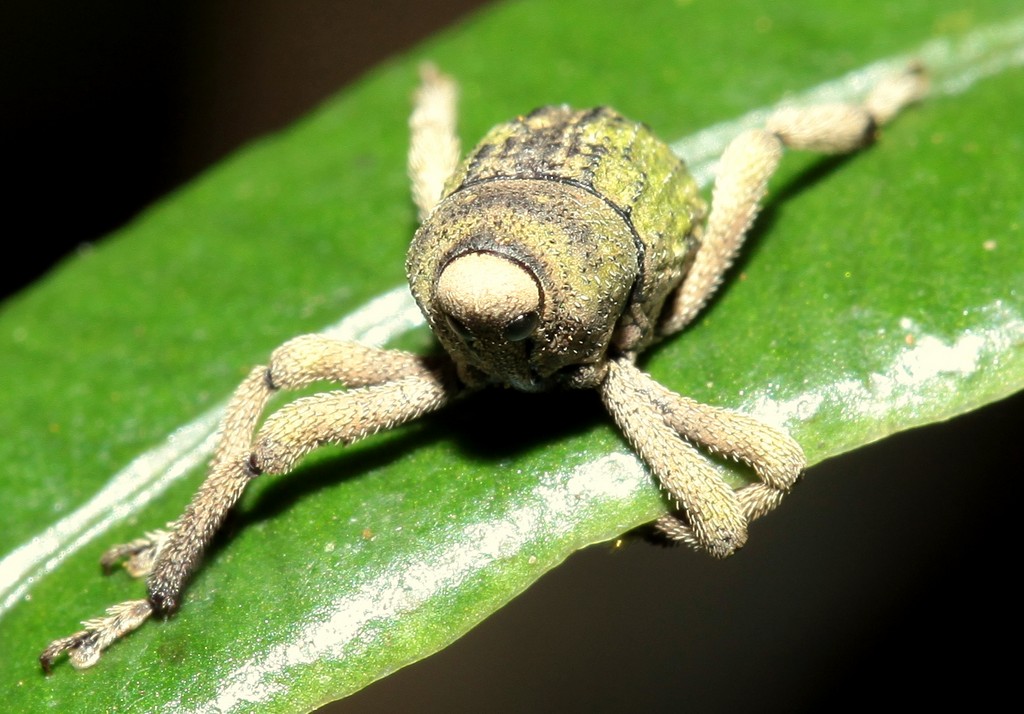ORTHORHINUS CYLINDRIROSTRIS - (FABRICIUS, 1775)
Class: INSECTA > order: COLEOPTERA > suborder: POLYPHAGA > superfamily: CURCULIONOIDEA > family: CURCULIONIDAE > subfamily: Molytinae > genus: Orthorhinus
Elephant Beetle, Elephant Weevil, Elefantenrüssler,
Description
Adults 10-20mm body length. Size and colour are extremely variable, typical specimens have a tubercle on each side of the pronotum near the apex. each elytron has two tubercles on the 2nd interstices, the 5th interstice has a similar tubercle on the posterior declivoty. The sexes are differentiated as follows: male has the antennae inserted much closer to the apex of the rostrum than the female, the forelegs of the male are much longer than in the female, the three basal tarsal segments of the fore tarsi are greatly expanded and ciliate in the male and not so in the female, the rostrum is more coarse, less clyindrical and somewhat shorter in the male than in the female; and the male is usually larger than the female. Length 10mm to 20mm. Females are shorter than males.
Distribution
Australia,Queensland, New South Wales, Victoria, South Australia and Tasmania. Reported from New Caledonia.
Biology
In Australia they are considered a major pest to wine companies.
The Elephant Weevil adults and larvae feed on eucalypts and a variety of other plants. They are a pest of cultivated vine crops.
The larva is a creamy white grub with a brown head and curl up to form a c-shape. The pupa starts of almost transparent and become darker brown as it develops.
Synonymes
Curculio cylindrirostris (Fabricius, 1775)
Curculio innubus (Herbst, 1795)
Orthorhinus longimanus (Boisduval, 1835)
Orthorhinus simulans (Boheman, 1835)
Orthorhinus tenellus (Pascoe, 1873)
Orthorhinus euchromus (Fairmaire, 1883)
Orthorhinus patruelis (Pascoe, 1885)
Orthorhinus vagus (Olliff, 1889)
Orthorhinus cylindrirostris albiceps (Lea, 1898)
Orthorhinus cylindrirostris pomicola (Lea, 1898)
Elephant Beetle, Elephant Weevil, Elefantenrüssler,
Description
Adults 10-20mm body length. Size and colour are extremely variable, typical specimens have a tubercle on each side of the pronotum near the apex. each elytron has two tubercles on the 2nd interstices, the 5th interstice has a similar tubercle on the posterior declivoty. The sexes are differentiated as follows: male has the antennae inserted much closer to the apex of the rostrum than the female, the forelegs of the male are much longer than in the female, the three basal tarsal segments of the fore tarsi are greatly expanded and ciliate in the male and not so in the female, the rostrum is more coarse, less clyindrical and somewhat shorter in the male than in the female; and the male is usually larger than the female. Length 10mm to 20mm. Females are shorter than males.
Distribution
Australia,Queensland, New South Wales, Victoria, South Australia and Tasmania. Reported from New Caledonia.
Biology
In Australia they are considered a major pest to wine companies.
The Elephant Weevil adults and larvae feed on eucalypts and a variety of other plants. They are a pest of cultivated vine crops.
The larva is a creamy white grub with a brown head and curl up to form a c-shape. The pupa starts of almost transparent and become darker brown as it develops.
Synonymes
Curculio cylindrirostris (Fabricius, 1775)
Curculio innubus (Herbst, 1795)
Orthorhinus longimanus (Boisduval, 1835)
Orthorhinus simulans (Boheman, 1835)
Orthorhinus tenellus (Pascoe, 1873)
Orthorhinus euchromus (Fairmaire, 1883)
Orthorhinus patruelis (Pascoe, 1885)
Orthorhinus vagus (Olliff, 1889)
Orthorhinus cylindrirostris albiceps (Lea, 1898)
Orthorhinus cylindrirostris pomicola (Lea, 1898)
